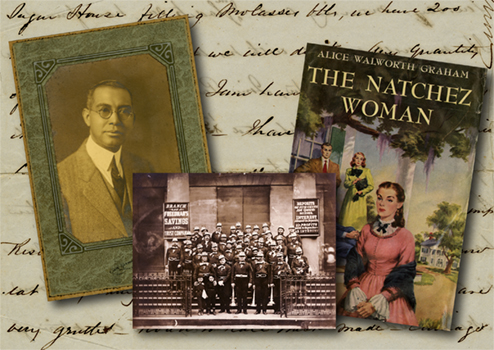Exhibition: "From Grand Village to Bluff City: 300 Years of Natchez History"
The Mississippi River’s fertile flood plain coupled with its role as a major economic artery connecting north and south firmly established the links between Natchez, Miss., and Louisiana early in their development as outposts of the colonial empires of multiple European powers. That connection continued into their respective American territorial periods, and by the antebellum era planters in the area had fully exploited this geographic partnership, taking up residence in Natchez city proper while keeping a firm eye on their profitable plantations across the river. Joined more than divided by the river, Natchez and Louisiana continue to have social, cultural, and economic ties.
In exploration of these enduring connections and in recognition of the tri-centennial of Natchez, LSU Libraries Special Collections presents the exhibition “From Grand Village to Bluff City: 300 Years of Natchez History, on display at Hill Memorial Library from June 13 – September 3, 2016. It is free and open to the public.
The exhibition showcases rare books, manuscripts, and 19th century photographs and examines the Natchez Indians; Natchez’s multi-national colonial past; the territorial and early statehood period; political and economic history; slavery, Civil War and Reconstruction; Natchez in the New South; 20th century economic development and the civil rights era; literary notables of Natchez; and the development of Natchez tourism.
“From Grand Village to Bluff City” reflects the diverse materials, stories and people of Natchez found among Special Collections’ holdings. “Why,” you may ask “does an institution in Louisiana have so much history about Natchez.” According to Tara Laver, Head of Public and Research Services and co-curator of the exhibit, “Historically, the political boundaries between Louisiana and southwest Mississippi were less important than their common experience, borne largely of their abiding relationship with the Mississippi River. Indeed, these associations informed LSU history professor Edwin Adams Davis as he began in 1935 systematically to collect the papers of the families that settled and prospered in the region.”
These materials became the foundation for the Louisiana and Lower Mississippi Valley Collections (LLMVC) within LSU Libraries Special Collections, one of the nation's premier repositories of historical documents materials relating to the antebellum plantation, Civil War, and Reconstruction South.

